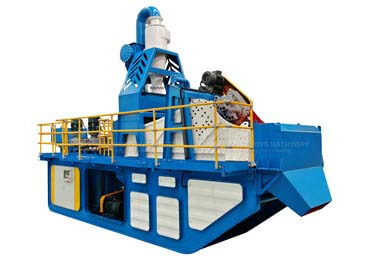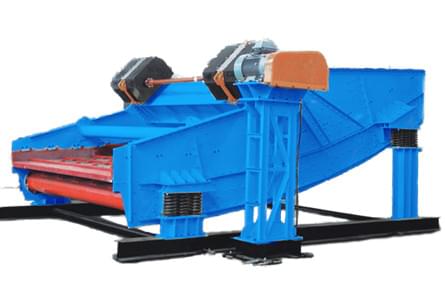Oil fracturing sand production process
The production process of petroleum fracturing sand is a new production process of petroleum fracturing sand, which uses bauxite, manganese powder, and additives as raw materials, and is crushed, dried, batched, pelletized, calcined, cooled, and screened. . The produced oil fracturing sand has the advantages of high strength, compression and wears resistance, high roundness, shock resistance, and good permeability resistance.
1. Crushing system for oil fracturing sand production process
The bauxite entering the factory has a block size of about 300~500mm and a moisture content of about 8%. After the bauxite enters the factory, it is stacked in the shed. The storage capacity is generally about one month.
The bauxite is shoveled into the silo by the forklift, and fed to the jaw crusher evenly and continuously through the plate feeder.
The crushed bauxite is stored in the buffer silo.
2. Oil fracturing sand production process bauxite drying system
The broken bauxite in the buffer silo passes through the belt conveyor and the hoist and enters the round silo at the top of the boiling furnace. A weighing belt feeder is set under the silo to make the broken bauxite evenly enter the dryer. The dried bauxite is sent to the dry bauxite storehouse (ingredient storehouse), or it can be sent to the stacking shed, and the storage time is generally about 5 days.
The boiling furnace produces hot flue gas at 800~900℃. Use low volatile coal as fuel. The crushed coal particles are 5~8mm and are fed into the furnace of the boiling furnace by the disc feeder. The automatic temperature control system is used to control the feeding speed of the disc feeder to stabilize the combustion temperature of the boiling furnace.
A bag filter is used to purify the exhaust gas from the dryer to achieve dust emission standards.
3. Oil fracturing sand production process batching station system
Bauxite, manganese powder, and additives are used for ingredients. All kinds of materials are transported to the batching warehouse. A speed regulating belt weighing feeder is set under the warehouse, and the automatic proportioning of materials is realized by the microcomputer batching system. The proportioned material enters the grinding system through the belt conveyor.
4. Grinding system for oil fracturing sand production process
The grinding system adopts a closed-circuit system to produce raw meal powder with a fineness of more than 500 meshes.
The mill adopts a three-storage tube mill. The powder separator adopts an O-sepa type * eddy current powder separator, and the fineness of the product can be easily adjusted by changing the rotating speed of the powder separator. The selected finished raw meal powder is collected by a high-concentration air box pulse bag filter and then sent to the raw meal round warehouse.
5. Granulation system for oil fracturing sand production process
The granulation adopts a new type of granulator developed by Zhengkuang Machinery Company. The granulator has the characteristics of fastball forming speed, high efficiency, good roundness, and clean production.
After the raw meal in the raw meal, the round silo is unloaded, it is conveyed to the silo at the top of the new granulator by screw conveyor and elevator. The screw weighing feeder is used under the silo to feed the raw meal into the granulator.
The granulation water is measured and put into the granulator. The ratio of raw meals and water can be adjusted.
The raw meal and water in the granulator are formed into raw meal pellets under the action of the stirring rod rotating at high speed and the inner cylinder rotating at low speed. After a certain period, the granulation is completed, and the raw pellets are discharged from the lower discharge pipe and fall onto the belt feeder. The raw pellets are transported to the dryer at the end of the kiln.
6. Kiln tail dryer system for oil fracturing sand production process
The water content of the newly-made pellets is about 15%. Using the waste heat from the kiln tail, the moisture content of the pellets can be reduced to about 8% in the kiln tail dryer, and then calcined in the kiln.
The kiln tail dryer adopts counterflow. The hot air end of the dryer is additionally equipped with a burner to provide hot air for the dryer when the heat of the exhaust gas at the kiln tail is insufficient.
The temperature of the exhaust gas at the kiln tail used by the dryer is about 500°C. After the use of the dryer, the temperature is reduced to about 150°C, which is suitable for the working condition of the kiln tail bag filter.
The raw meal pellets coming out of the dryer are stored in the intermediate silo for use in the rotary kiln.
7. Rotary kiln system for oil fracturing sand production process
The dried raw meal pellets are discharged from the intermediate silo and lifted to the end of the kiln by the hoist. The vibrating screen classifies the raw meal pellets into qualified and unqualified. Qualified raw meal particles enter the rotary kiln for calcination, and unqualified raw meal particles are returned to the grinding system.
In the rotary kiln, with the rotation of the rotary kiln, the raw meal particles gradually move towards the kiln head and are calcined into petroleum proppant ceramsite sand at the temperature of 1300℃~1350℃ in the firing zone. The ceramsite sand enters the single-cylinder cooler for cooling, and the secondary air of the cooler enters the rotary kiln.
8. Kiln tail dust collection system for oil fracturing sand production process
A bag filter is used to purify the kiln tail gas (including the waste gas from the kiln tail dryer). A humidification tower is installed at the end of the rotary kiln to cool the exhaust gas at the end of the kiln so that the temperature of the exhaust gas can be reduced to the required temperature of the bag filter.
The discharge concentration of the bag filter can reach below 30mg/Nm3, achieving standard discharge and clean production.
9. Finished system of petroleum fracturing sand production process
The ceramsite sand from the cooler is lifted to the vibrating screen, divided into different particle sizes according to the standard requirements, and entered into different finished product warehouses. An electronic weighing scale is set under the warehouse. The bagged products with qualified weight are sealed by the sewing machine. Stacked in the finished product warehouse for shipment.
Performance requirements for oil fracturing sand production process
1. Oil fracturing sand must have sufficient compressive strength and wear resistance, can withstand strong pressure and friction during injection, and effectively support artificial fractures.
2. The relative density of oil fracturing sand particles should be below, which is convenient for pumping downhole.
3. Under the condition of temperature of 200 degrees, the oil fracturing sand particles will not have a chemical interaction with fracturing fluid and reservoir fluid, and the maximum allowable value of acid solubility should be less than 7%.
4. The oil fracturing sand particles are relatively uniform and cannot be of different sizes









